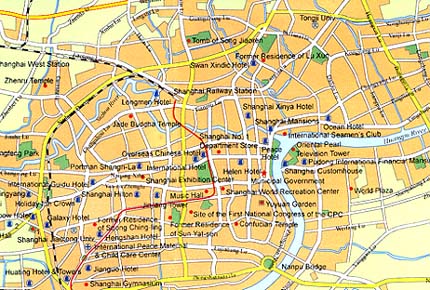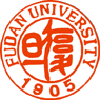Shanghai Facts & District Guide
Shanghai, situated on the banks of the Yangtze River Delta in East China,
is the largest city of the People's Republic of China and the seventh largest
in the world. With one of the world's busiest ports, Shanghai also serves
as one of the nation's most important cultural, commercial, financial,
industrial and communications centers. Administratively, Shanghai is a
municipality of the People's Republic of China that has province-level
status.
Originally a fishing town, Shanghai is currently one of China's most important
cities. The city often reflects the pop culture, intellectual advances
and political systems of the Republic. In the late nineteenth century and
early twentieth century, Shanghai was the third largest financial center
in the world, ranking after New York City and London, and the largest commercial
city in the Asia.
After the communist takeover in 1949, Shanghai languished because the
central government taxed heavily and foreign investments cease, purging
the city of its "bourgeois" elements. In 1992,
the central government authorized market-economic which redeveloped Shanghai.
Now, the city has surpassed early-starters Shenzhen and Guangzhou, leading
China's skyrocketing economic growth. Still, challenges remain as the city
struggles with economic disparity and overwhelming numbers of migrating
workers. As challenges remain to be overcome, Shanghai's prosperous economy
and lifestyle represents China's recent economic development.
Shanghai City
Facts
Shanghai District Guide
| Population |
17 Million |
| Land Area |
6200 square km |
| County Level Divisions |
19 |
| Number of Districts |
18 districts + 1 county |
| Country Code |
86 |
| City Code |
21 |
| Postal Code |
200000 - 202100 |
| Municipality |
18,670,000 km2 |
| Elevation |
43.5 meters (142.7 feet) |
| Density |
2,945 / km2 (7,627.5 / sq mi) |
| Main Inhabitants |
Han nationality makes up 99% of total population |
| Religion |
China is officially atheist, but traditionally pragmatic and eclectic. Some 2% to 3% of the population practice Daoism (Taoism), Buddhism and Islam. An estimated 1% are Christians. |
| Dialect |
Shanghai dialect; official government language is Mandarin. |
| Electricity |
220 volts |
Shanghai is administratively equal to a province and is divided
into 19 county-level divisions: 18 districts and 1 county.
There is no single downtown district in Shanghai, the urban
core is scattered across several districts.
Prominent central business areas include Lujiazui on the east
bank of the Huangpu River, and The Bund and Hongqiao areas
in the west bank of the Huangpu River. The city hall and major
administration units are located in Huangpu District, which
also serve as a commercial area, including the famous Nanjing
Road.
Other major commercial areas include the classy Xintiandi
and Huaihai Road in Luwan district and Xujiahui in Xuhui District.
Many universities in Shanghai are located in residential areas
of Yangpu District and Putuo District.
Nine of the districts govern Puxi (literally HuangpuRiver west),
or the older part of urban Shanghai on the west bank of the
Huangpu River. These nine districts are collectively referred
to as Shanghai Proper or the core city. Most of the city's
high quality residences, shops and restaurants are located
within central Shanhai.

Huangpu District, Central Shanghai
Central Huangpu District includes the Bund (which is along the Huangpu River), the Nanjing Road Pedestrian Mall, People's Square and Yuyuan Garden. Opposite the Huangpu River is a spectacular view of the new Shanghai building boom including the Oriental Pearl TV Tower and the Jin Mao Tower, which are among the city's top tourist destinations. As the oldest district in Shanghai, the Huangpu District is the center of administration, culture and trades, as well as the most extravagant area in Shanghai. It has the most historical places in the city, a shopping heaven, a tourist spot as well as a modern international residential area.
Luwan District, Central Shanghai
Luwan district is located in the center of Shanghai, directly
south of People's Square. The north part of Luwan includes
one of the best sections of Hua Hai Road, famous for its
shops and restaurants. Luwan is also where you will find
the beautiful old French Concession area located, one of
the most prestigious sections of the city.
Jingan District, Central Shanghai
Jing An District, in the center of Shanghai, has an area
of 7.62 square kilometers and is by far the most populated
area of downtown Shanghai. This district is where the 750
year old Jing An Temple located, the Temple of the Jade Buddha
and Nanjing Road where the best shopping in the city is found.
Nanshi District, Central Shanghai
Nanshi District borders the Huangpu river and includes such
well known landmarks as the Nanpu Bridge and YuYuan Garden,
a top tourist destination of old Chinese gardens, antique
shops, teahouses and restaurants.
Xuhui District, Southwest Shanghai
Xuhui District is located to the southwest of central Shanghai.
Xuhui District, together with Luwan District is what is commonly
referred to as 'downtown' Shanghai. This district is considered
the safest part of Shanghai and most embassies and consulates
are located here. Xuhui has the lowest population density
of the downtown districts, but the highest concentration
of cultural and scientific institutions. Xuhui has traditionally
been an upper class living area and recent development has
born that out with many luxurious villas and apartments being
developed in Xuhui. The area still has many beautiful old
villas left over from colonial days, most in rough shape
but some currently being renovated as single family homes.
The convergence of 5 main roads (including Huai Hai Road)
in Xujiahui represents the main center in the district.
The Shanghai Catholic Cathedral, Longhua Temple and Shanghai
Olympic Stadium are some of the main features of this area. You
can also find the Huating Hotel and Regal East Asia Hotel right
by the stadium.
Hongqiao Area, Changning District, West Shanghai
Located to the west of central Shanghai, the Changning District
covers 37.19 square kilometers. Hong Qiao is actually a special
economic zone within Changning District and is best know
for its airport (for many years the only airport in the city),
the zoo and expatriate communities. This district is the
biggest high-grade dwelling area for foreigners in Shanghai.
It has many western style residential compounds as well as
apartments and villas, with gardens, pools, tennis courts
and gyms. Sights in the area include the Shanghai Zoo, the
Xi Jiao Guest House and Sassoon Park Gardens. The Westin
Tai Ping Yang and Yangtze River Hotels as well as the Friendship
Store and Shanghai Mart are also found in this area.
Gubei Area, Changning District, West
Shanghai
Gubei Area is a residential area within Hong Qiao with medium
and high rise apartment towers and charming villa compounds
that are home to many foreigners. Residential areas such
as the Rotterdam Gardens, Villas De Versailles and Rome Garden
have European styles that give the viewers a feel of Europe
in the middle of Shanghai. In this district you will find
the large Carrefour supermarket and many western shops and
restaurants. Gubei is also close to all forms of public transportation.
The elevated highway is nearby and is very convenient for
travel to just about any part of the city.
Pudong District
On the east of Huangpu River and west of the mouth of Yangtze
River, Pudong District is a fast growing area of 556 square
kilometers. Visitors can travel to Pudong from downtown Shanghai
via a number of bridges, tunnels, ferries and the new Number
2 Shanghai Metro line.
The Pudong District has seen massive growth in the past ten
years. They have a vast multitude of multinational & Joint
Venture high-tech industries and factories producing some of
the world's top brand names. The foreign community continues
to grow as new factories open in Pudong's tax free zones. Large
luxury expatriate housing is continually being built to keep
up with the demand for residential property suitable for foreigners.
Lujiazui Business Area, Pudong District
The Lu Jia Zui Business area lies on the Huang Pu riverside,
and is located directly across from the Bund. Lu Jia Zui
is home to the two most popular buildings in Shanghai: the
Jin Mao Tower and the Oriental Pearl Tower. The Oriental
Pearl TV Tower has become the new symbol of the city, and
work has begun on the world's tallest building in Lujiazui
.Offices and residential apartment buildings in Lujiazui
are some of the best in the city, including Summit
Residences and Chrysanthemum
Park.
Jinqiao Export Processing Zone, Pudong District
JinQiao Export Processing Zone is a big area which the government
offers companies tax incentives to station their offices
there. Hence, many major companies such as Shanghai GM, Hewlett-Packard,
Kodak, Sharp, Ricoh, NEC, Mitsubishi, Philips, Whirlpool,
Siemens and many others positioned their office here. Many
high end villas offer first-class living and are home to
many expatriate families. Jin Qiao is conveniently located
just 20-30 minutes from Pudong International Airport and
has its own Carrefour and OBI supermarkets.
Northeast Shanghai
The Northeast area of Shanghai doesn't have the high concentration
of upscale shops and restaurants found in the more central
districts. The living environment is pleasant and safe, but
there are definitely fewer amenities for foreigners in the
Northeast area.
Yang Pu District, Northeast Shanghai
Yang Pu District is in the northeast area of Shanghai. It
is home to the YangPu Bridge, one of the two main bridges
spanning the Huang Pu River. The YangPu District has over
100 research institutes. It also boasts 25 colleges and universities
including such well known institutions as Fudan University,
Tongji University and the Shanghai Foreign Language University.
HongKou District, Northeast Shanghai
Chinese philosopher and writer Lu Xun lived and wrote near
HongKou Park. Nowadays the area is home to the largest and
most modern soccer stadium in the city, HongKou Stadium.
Bordering the HuangPu River and Suzhou Creek, HongKou
District enjoys a great geographical location.
Bordering both the Huang Pu River and Suzhou Creek in the northern Shanghai, the
HongKou District has a great geographical location. The district is the home
to famous universities such as Shanghai International Studies and Shanghai University
of Finance and Economics.
The area is home to the most modern football (also called
soccer) stadium in the city, the Hongkou Stadium. Currently
it is the only stadium used solely for football matches in
China. There are numerous tourist attractions in the district
such as the former residences of modern prominent literature
figures and memorials and parks. Chinese philosopher and writer
Lu Xun lived and wrote near HongKou Park.
Everbright City ,
Zhabei District
Located in the northern portion of Shanghai, the Zhabei District
does not have much Western standard accommodation, shopping
or entertainment. On the other hand, many foreign students
prefer to live in this area because the inexpensive apartments
here are quite easy to find, and the metro makes it easy
to go to just about everywhere else in the city. The Shanghai
Railway Station with train connections to just about all
parts of China is located within this area. Zhabei gained
the nickname "Everbright City", because the dull area during
daytime lights up at night and transforms into a carnival,
with lots of nightclubs and restaurants that attract many
young Shanghainese.
NOTE: Although
this information is correct at the time of our web publication,
it is still advised that you call the phone number and confirm
the address before going to the venue because some venues may have
changed their telephone numbers or address locations.
|



